Hurray for Liberty Bonds!
by Bob Brooke
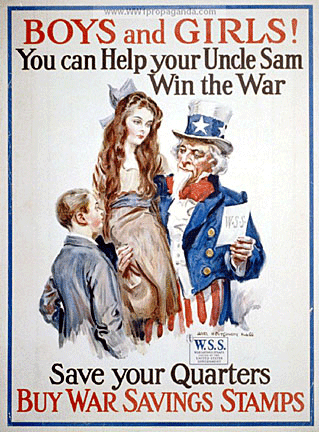 People
born in the 1940s grew up with Liberty Bonds. Back then, most called
them just savings bonds. They were a favorite gift to kids at
birthdays and other major events. Most the people who gave or
received these bonds never realized that there were so many things
associated with them. People
born in the 1940s grew up with Liberty Bonds. Back then, most called
them just savings bonds. They were a favorite gift to kids at
birthdays and other major events. Most the people who gave or
received these bonds never realized that there were so many things
associated with them.
Although people rarely discussed them, there are probably thousands
sitting in safe deposit boxes. In fact, these bonds have been around
for over 100 years. A Liberty bond was a war bond that the U.S.
Government sold to support the allied cause in World War I.
Subscribing to the bonds became a symbol of patriotic duty in the
United States and introduced the idea of financial securities to
many citizens for the first time.
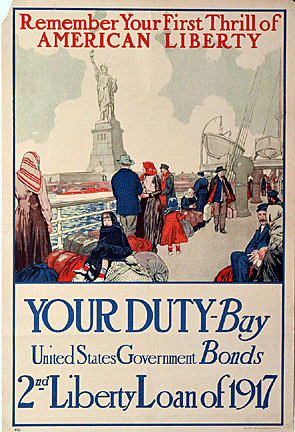
These bonds were a direct and unconditional promise of the U.S.
Government to pay upon a certain date a specified sum of money in
gold, together with interest at a specific rate, payable at specific
dates until the bond matured Only by holding a bond to maturity
could people collect the amount they paid plus interest.
“The Great War,” as World War I was known at the time, was an
emotional issue. Not everyone was for it. The federal government
knew that to wage a massive offensive against the Germans would cost
a great deal of money. One third of the cost came from the revival
of the personal income tax and an excess profits tax for businesses.
The balance was to be raised by the sale of treasury bonds. The
government would be asking people to dig deep into their pockets and
purchase billions of dollars worth of Liberty Savings Bonds, as they
came to be called.
But to get all Americans to buy these bonds took a Herculian
advertising and promotional campaign which began in May of 1917. The
various Federal Reserve Banks formed committees, on a state-by-state
basis, which in turn organized vast numbers of volunteers.
Entertainers, politicians, clergymen and persons from all walks of
life took part in selling Liberty Bonds.
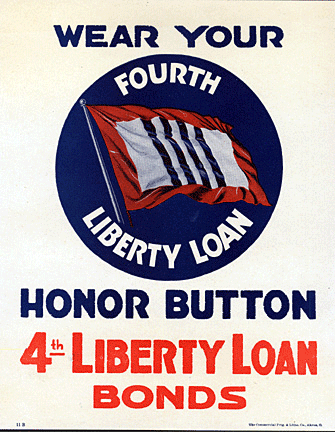 People
couldn’t avoid the bond salesmen. They stood on street corners. The
Boy and Girl Scouts went door-.to-door. Volunteers sold bonds in
every movie house, theater and concert hall, and during lunch breaks
at thousands of factories. They came to be called "four-minute men"
because of the length of time they spoke, appealed, pleaded and
lectured on the necessity of buying bonds. From the war front came
wounded heroes, especially fliers, to tour the nation and to attend
mass public rallies. Banks even offered to lend money for bond
purchases. Celebrities conducted frequent public rallies, usually in
theaters. Movie stars came out solidly to lead many of them. People
couldn’t avoid the bond salesmen. They stood on street corners. The
Boy and Girl Scouts went door-.to-door. Volunteers sold bonds in
every movie house, theater and concert hall, and during lunch breaks
at thousands of factories. They came to be called "four-minute men"
because of the length of time they spoke, appealed, pleaded and
lectured on the necessity of buying bonds. From the war front came
wounded heroes, especially fliers, to tour the nation and to attend
mass public rallies. Banks even offered to lend money for bond
purchases. Celebrities conducted frequent public rallies, usually in
theaters. Movie stars came out solidly to lead many of them.
It all began on April 25, 1917 when Congress approved the Liberty
Loan Act which gave authority to the Secretary of the Treasury to
issue $2 billion of 31/2-percent convertible bonds for sale by
public subscription. Interest rates were raised to 4 1/4 and 4˝
percent in later offerings. In all there were five subscription
drives, the first four being numbered consecutively.
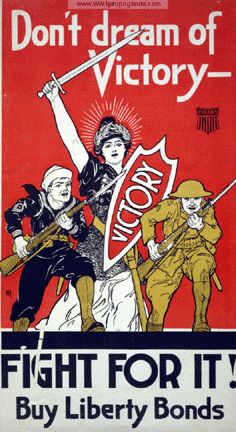 The
First Liberty Bond Drive commenced May 14, 1917, the day the United
States declared war on Germany. Others followed in October of that
year, and in April and October 1918. A Victory Liberty Loan
subscription bond drive, the funds of which went to aid our
exhausted Allies, took place in April 1919 and it, too, was a
success. People could purchase bonds in denominations from $50 to
$100,000. The five drives of from 1917to 1919 resulted in 22 million
bonds sold. The
First Liberty Bond Drive commenced May 14, 1917, the day the United
States declared war on Germany. Others followed in October of that
year, and in April and October 1918. A Victory Liberty Loan
subscription bond drive, the funds of which went to aid our
exhausted Allies, took place in April 1919 and it, too, was a
success. People could purchase bonds in denominations from $50 to
$100,000. The five drives of from 1917to 1919 resulted in 22 million
bonds sold.
The sale of all these bonds also produced a lot of memorabilia,
mostly ephemera. Collectors became interested in the late 1970s.
Posters were the first items to become popular, followed by pinback
buttons and postcards. Soon all ephemera, including handbills,
magazine covers and advertisements, postal slogan cancels and
promotional literature was being collected.
A federal agency headed by Charles Dana Gibson organized the
nation's illustrators and painters to churn out patriotic posters,
including many for the Liberty Bonds program. James Montgomery Flagg,
J.C. Leyendecker and Haskell Coffin were just a few of the hundreds
lending their talents and donating their time.
War Savings Stamps booklets, used to hold 25-cent or 50-cent stamps,
that when filled were turned in for a bond, delight many collectors
as do the various booklets the government furnished to its army of
volunteer salesmen and speakers.
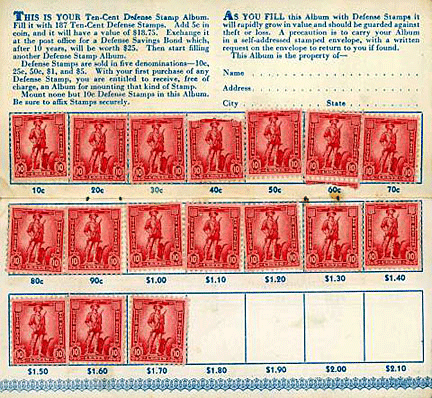
The U.S Postal Service issued postcards to dramatize the appeal. Various
artists contributed their skills toward creating many fascinating poster
art cards. A special effort was a seven-card sepia set that was used to
bombard the mailboxes of most every American. Each card began "Liberty
Bonds Guarantee.. "with a different listing of objectives, such as
"Liberty Bonds Guarantee Unlimited Aeroplanes. ..our Flyers must control
the air." This card showed a dozen military biplanes in flight.
The U.S. Army printed another sepia set, taken from photographs in the
field, which they gave to doughboys to mail back home. Inscribed "U.S.
Army Post Card" on the address side, the pictorials pictured the various
implements of war that Liberty Bonds were buying, such as howitzers,
tanks and food. Captions emphasized the need to buy bonds: "Liberty
Bonds will keep these howitzers thundering at the Huns," etc.
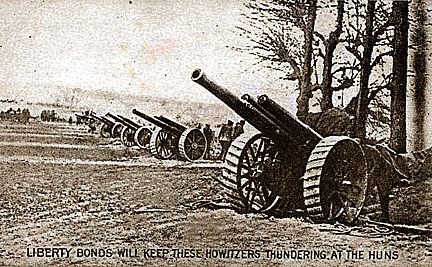
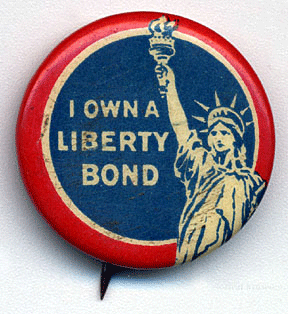 Volunteers
handed out small pictorial stickers to bond subscribers who proudly
displayed them on their front door or living-room windows. Buying a bond
also earned purchasers a special pinback button to wear. Several
different varieties issued; some for specific drives, others for general
use. Different companies manufactured theirs for the government,
including Animated Toy Company of New York, American Art Works of
Coshocton, Ohio, Ehrman Manufacturing Company of Boston, and Manee
Company of Malden, Massachusetts. Volunteers
handed out small pictorial stickers to bond subscribers who proudly
displayed them on their front door or living-room windows. Buying a bond
also earned purchasers a special pinback button to wear. Several
different varieties issued; some for specific drives, others for general
use. Different companies manufactured theirs for the government,
including Animated Toy Company of New York, American Art Works of
Coshocton, Ohio, Ehrman Manufacturing Company of Boston, and Manee
Company of Malden, Massachusetts.
Volunteers also distributed small poster stamps so people could paste or
glue them on to stationery, envelopes and postcards. These usually had
patriotic motifs, especially flags, shields and the American eagle.
There were also 10-cent savings stamps that could be purchased and glued
into booklets.
<
Back to Caring for Your Collections
Archives
Next Article >
|
